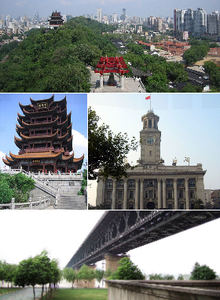Wuhan
Wuhan (Chinese: 武汉) is the capital of Hubei province, People's Republic of China, and is the city with most people in Central China.[1] It is at the east of the Jianghan Plain, where the Yangtze and Han rivers meet. Joining three nearby cities, Wuchang, Hankou, and Hanyang, Wuhan is a center of transportation, with many railways, roads and expressways passing through. Because of its important role in transportation, Wuhan was sometimes called the "Chicago of China."[2][3] It is also recognized as the political, economic, financial, cultural, and educational center of central China.[1]


The city of Wuhan, first called so in 1927, has 10,020,000 people (as at 2011).[4] In the 1920s, Wuhan was the national capital of a Kuomintang (KMT) government led by Wang Jingwei when he was against Chiang Kai-shek,[5] and it was also the capital in 1937.[6][7]
References
change- ↑ 1.0 1.1 "Focus on Wuhan, China". The Canadian Trade Commissioner Service. Archived from the original on December 12, 2013. Retrieved February 10, 2013.
- ↑ "Foreign News: On To Chicago". Time magazine. June 13, 1938. Archived from the original on January 5, 2012. Retrieved November 20, 2011.
- ↑ Jacob, Mark (May 13, 2012). "Chicago is all over the place". Chicago Tribune. Archived from the original on May 11, 2013. Retrieved May 22, 2012.
- ↑ "武汉市2011年国民经济和社会发展统计公报". Archived from the original on January 2, 2013. Retrieved March 24, 2012.
- ↑ Stephen R. MacKinnon (2002). Remaking the Chinese City: Modernity and National Identity, 1900-1950. University of Hawaii Press. p. 161. ISBN 978-0824825188.
- ↑ "AN AMERICAN IN CHINA: 1936-39 A Memoir". Archived from the original on May 12, 2013. Retrieved February 10, 2013.
- ↑ Stephen R. MacKinnon (21 May 2008). Wuhan, 1938: War, Refugees, and the Making of Modern China. University of California Press. p. 12. ISBN 978-0520254459.